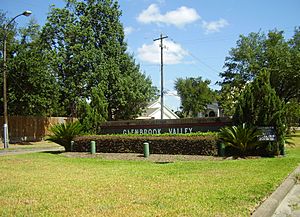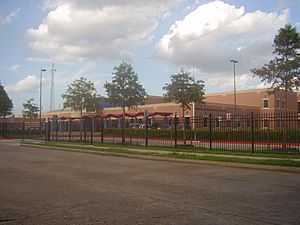Glenbrook Valley, Houston facts for kids
Glenbrook Valley is a neighborhood found in Houston, Texas, United States. It was created by Fred McManis, Jr.
Contents
History of Glenbrook Valley
How Glenbrook Valley Started
Glenbrook Valley was built between 1953 and 1962. A design team called Hare and Hare from Kansas City, Missouri, planned the community for Fred McManus, who was the developer.
The first part of the neighborhood opened in 1954. Six of the first homes were shown in the 1954 "Parade of Homes." This was an event put on by the Greater Houston Builders Association. At one point, people in Houston called Glenbrook Valley the "Little River Oaks." The magazine Better Homes and Gardens even called one of these model homes "the model home for all America." The Houston Press newspaper said Glenbrook Valley was a "showpiece suburb." It was seen as a modern vision of the future, like something from the George Jetson cartoons.
Changes Over Time
As years passed, Houston grew more towards the west. The Houston Press noted that this made older areas like Glenbrook Valley less noticed for many years. An economic downturn in the 1980s also caused the community to decline. Many older residents moved away, and some houses were not kept up well.
In 2007, some residents of Glenbrook Valley shared concerns with Mayor of Houston Bill White. They were worried about a nearby complex called Thai Xuan Village. Robert Searcy, a realtor and civic club member, said it was affecting property values in Glenbrook Valley.
Becoming a "Hidden Gem"
In 2009, the Houston Press named Glenbrook Valley the "Best Hidden Neighborhood" in Houston. They said that younger people were starting to look at neighborhoods on the east side because west side areas had become very expensive. In 2010, the Houston Press also called Glenbrook Valley one of Houston's Most Underrated Neighborhoods. Richard Connelly from the newspaper said the neighborhood's website "embraces the `60s feeling." He also noted that residents were working hard to protect the area's history.
Becoming a Historic District
In 2008, members of the Glenbrook Valley Civic Club and Robert Searcy started a project. They wanted Glenbrook Valley to become a special historic district recognized by the city. This would make it the first historic neighborhood in Texas with buildings from after World War II. Volunteers asked residents to sign a petition to approve this idea.
According to Marlene Gafrick, who worked for the City of Houston, 54% of residents signed the petition. Only 51% approval was needed for the historic district to be approved. After some disagreements within the community, the Houston City Council made Glenbrook Valley a historic neighborhood in June 2011. It was the first one outside the 610 Loop.
What Glenbrook Valley Looks Like
Neighborhood Layout
Glenbrook Valley has 1,256 houses spread across thirteen sections. It is located on the south side of the Sims Bayou. The neighborhood is divided into four parts by the intersection of Bellfort Avenue and Broadway Boulevard. The main boundaries of the community are roughly William P. Hobby Airport, the Sims Bayou, Telephone Road, and Interstate 45 (Gulf Freeway).
The Houston Press said in 2009 that Glenbrook Valley "reminds us of a much more stylish Sharpstown." It has houses that look like they belong in the TV show Mad Men, set on very large lots. Ruth Samuelson of the Houston Press described the area as having "quiet, winding streets behind Broadway." These streets are lined with mid-century modern houses and neat lawns.
Unique Homes and Value
Many houses in Glenbrook Valley were built after World War II. Because of the economic downturn in the 1980s and certain rules about the properties, new developers did not build in Glenbrook Valley by 2011. Steve Jansen of the Houston Press said that year, "Though some unique homes were remodeled beyond original recognition, a passerby won't see McMansions and loftzillas." Instead, people could find large homes that might need some updates for around $190,000.
Robert Searcy, a realtor, said in 2011 that Glenbrook Valley is "an area that sits almost untouched, like a time capsule." He also mentioned that many people looking for homes in Greater Houston tend to move to areas like Oak Forest and Westbury instead. Searcy called Glenbrook Valley a "diamond in the rough" because it's a great place that many people don't know about.
Steve Jansen also noted in 2011 that most Houstonians are not familiar with Glenbrook Valley.
Who Lives in Glenbrook Valley
Community Demographics
As of 2011, many residents of Glenbrook Valley are African Americans, Hispanic Americans, and Vietnamese Americans. Many people from the latter two groups have limited English fluency.
City data from June 2011 showed that the average household income in Glenbrook Valley was $37,860.
During the "Space Age" (the 1950s and 60s), many Italian Americans moved to Glenbrook Valley.
Education in Glenbrook Valley
Local Schools
Glenbrook Valley is part of the Houston Independent School District.
The Bellfort Early Childhood Center serves the community. Most children attend Lewis Elementary School. Some residents go to Cornelius Elementary School or Park Place Elementary School. All students in the area attend Ortiz Middle School and Chávez High School.
Before Ortiz Middle School opened in 2002, students went to Stevenson Middle School. Before Chávez High School opened in 2000, students attended Milby High School.
Public Libraries
The Houston Public Library has the Park Place Regional Library close to Glenbrook Valley.
Parks and Fun
Dow Park is located in Glenbrook Valley. It has walking trails, a baseball field, three tennis courts, and a playground.



